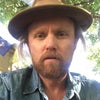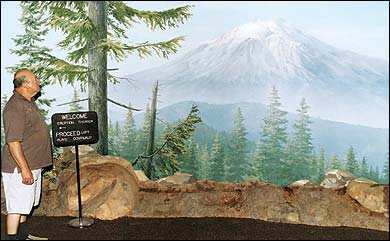THE SUN HAS RISEN, evaporating the clouds wrapped around Mount St. Helens, and if you look closely you can see what might be steam rising from its crater. Or is that a cloud? All along the Spirit Lake Highway, gawkers are scrambling for a vantage point. Parked cars hug the shoulder, where hundreds of people have staked their plots with lawn chairs, tripods, and video cameras.
mount st helens
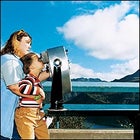 Waiting for the big one: volcano watch at the Coldwater Ridge Visitors Center
Waiting for the big one: volcano watch at the Coldwater Ridge Visitors Centermount st helens
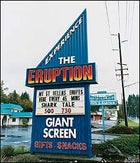 The virtual volcano in Castle Rock
The virtual volcano in Castle Rockmount st helens
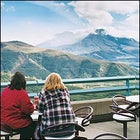 Waiting for the big one: volcano watch at the Coldwater Ridge Visitors Center
Waiting for the big one: volcano watch at the Coldwater Ridge Visitors Centermount st helens
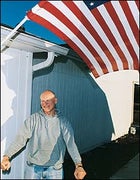 God only knows! Lloyd Anderson, proprietor of the Seven Wonders Museum, in Toutle, Washington
God only knows! Lloyd Anderson, proprietor of the Seven Wonders Museum, in Toutle, Washington
This wide-laned tourist conduit used to dead-end at the U.S. Forest Service's Johnston Ridge Observatory, just five miles from the steaming crater. But when the mountain began threatening to erupt in late September, that observatory was closed, and now the road terminates nine miles sooner, at the Coldwater Ridge Visitors Center. Three miles shy of the place, 40 TV trucks are lined up at an overlook, satellite dishes cocked toward the horizon like a row of big white daisies. Satellite City growls with generators and the smell of diesel as reporters dab themselves with makeup in their rearview mirrors, then go live, beamed around the globe from the flat-topped shadow of the hulking volcano, right here just 50 miles north of Portland, Oregon.
Everyone wants to get closer. Hovering in choppers above the crater itself, scientists are practicing commando volcanology, dangling instruments from cables, hauling ass when an ash cloud explodes their way. We're all envious: How come they get to do that? A few days ago, one adventurer flew all the way from New Jersey to Portland, took an $80 cab ride to the town of Cougar, 12 miles south of the volcano, and sneaked past the blockades to climb the mountain, only to call 911 for rescue from the closed climber's bivouac at 3,765 feet. Later this week another daredevil will make it to the crater's rim, at 8,365 feet, shoot video of the steaming magma dome, and sell it to Portland news channel KGW.
Like them, I am eager. And like the thousands of other pilgrims drawn to southwestern Washington, I am decidedly not neutral. I am a taxpayer, and frankly I feel entitled to see an eruption. It's still October: Bush hasn't won yet, and between the war in Iraq and the recession and the election threatening to tear the country in two, the American psyche needs a cosmic release. I want to see the thing blow.
I finally inch my rental car into the Coldwater parking lot, where two female rangers in olive-green uniforms and neon-orange hazard vests are directing traffic. One of them is kneeling, her forearms flat on the ground and an ear to the asphalt. Oh, this is good! She must be monitoring seismic activity beneath the parking lot.
“Can you hear anything?” I blurt out the car window.
She looks up at me, perplexed.
“Is the ground trembling?” I call. “Are we safe?”
“I'm just stretching,” she says. “It's a yoga pose.”
EXCUSE MY ENTHUSIASM. It's my first actual sighting of the volcano. Like everyone else, I've been watching breathlessly online since she awakened after years of slumber with a swarm of hundreds of mini-earthquakes. On September 26, the U.S. Geological Survey announced a yellow alert. We all saw that Homeland Security guy and his chartÔÇövolcanoes use the same colors, duhÔÇöand we knew what to expect next. Three days later we got orange, to which the mountain responded with a 25-minute steam emission, and on October 2 we went red. To volcanologists, that translated as “large ash eruptions expected or confirmed, plume likely to rise 25,000 feet above sea level.” To the rest of us it just meant Hell, yeah!
In 48 hours, the Forest Service's VolcanoCam Web page got 23 million hits. Meanwhile, the agency evacuated thousands of looky-loos from Johnston Ridge, the observatory named after the young geologist who died in that very spot in 1980, buried beneath millions of tons of debris while radioing his final words to USGS headquarters: “Vancouver, Vancouver! This is it!”
Today Mount St. Helens is the only active volcano in the lower 48. (There are 46 in Hawaii and Alaska.) But until 1980, she'd been sitting quietly for more than a century. Like the 12 other major volcanoes in the Cascade RangeÔÇöall dormant, including Washington's Mount Rainier, Oregon's Mount Hood, and California's Mount ShastaÔÇöSt. Helens sits along the Ring of Fire, a chain of volcanoes encircling the Pacific wherever continental plates collide, as the Juan de Fuca and North American plates do off the northwest coast.
No one alive on May 18, 1980, can forget the day Mount St. Helens erupted. A 5.1-magnitude earthquake triggered the collapse of the mountain's north flank, unloosing the biggest landslide ever recorded and an eruption equal to 500 Hiroshimas. Picturesque Spirit Lake, at the foot of the mountain, was buried under 200 feet of rubble. Melting glaciers swelled rivers, consuming the old two-lane road leading up from the logging town of Toutle in floods of mud and ash. The cloud blew 16 miles into the atmosphere, blanketed the Northwest with ash, and circled the globe in 17 days. It was the largest eruption in the recorded history of North America.
The lead-up back then was similar to what's going on today: In March 1980, a few small emissionsÔÇöthe first since 1857ÔÇöbrought media and rubberneckers out in droves, but after two months of watching the magma dome in the volcano's crater slowly bulge, people lost interest. Nobody, not even the scientists, was prepared for what happened next. As the mountainside collapsed, the eruption blasted not just upward but sideways, instantly flattening 86,000 acres of forest. Anything caught in the blast zone, which extended 17 miles to the north, was incinerated by 600-degree, 300-mile-per-hour winds. In all, 57 people died that morning, most of them suffocating in the falling ash.
This time around, volcanologists think they can better predict what the mountain will do. While we in the live audience inch our lawn chairs closer to the volcano, the scientists hunker down 40 miles away at the USGS Cascades Volcano Observatory, next to some tract houses and a mini-mall in an office park outside Vancouver, Washington. They pore over the latest data from monitors inside the crater and then try to figure out what to tell the reporters.
For today's volcano-side press conference, they've sent over research hydrologist Larry Mastin, all spiffed up in a kelly-green USGS golf shirt and ball cap. Holding his ground against the out-thrust microphones of the volcanazzi, Mastin has the mix of brawn and brains that we demand in a volcanologist. One minute he recounts cruising low in a chopper over the smoldering crater; the next he answers a reporter's question about the size of the mountain's expanding lava dome with “Well, ¤Çr2 x h would give you the volume.” We all nod and act like we know what he's talking about, scrambling for the winning words to decipher his technical jargon: The thing bulging in the crater becomes the dome, the lobe, the fin, the blister. When something shoots from the top of the crater, it is an emission, a hiccup, a burp, a belch.
But we want hard news, a bankable doomsday predictionÔÇösomething like “You ain't seen nothin' yet!” or “Hasta la vista, Portland!” Mastin won't commit, insisting that, even with 50 scientists and a zillion dollars' worth of technology, the best volcanologists can do is guess. “It's like trying to predict what a one-year-old child will do ten minutes from now,” he says.
If there's one thing scientists do seem sure of, it's that Mount St. Helens will not erupt as violently as it did 24 years ago. On the vaguely titillating Volcanic Explosivity Index, which ranges from “gentle” (1) to “mega-colossal” (8), the 1980 event was a 5: “paroxysmal.” It removed the top 1,300 feet of the mountain and a good chunk of the crater's north flank. Simply put, there's nothing to blow off anymoreÔÇöthe cork is gone from the champagne bottleÔÇöand what magma emerges will most likely eek out slowly. Scientists have clocked the 2004 activity at a meager 1, and even if the mountain were to reach a “cataclysmic” 4, as they say it could, the eruption would shoot upward rather than sideways, sparing the visitor centers and news trucks.
Still, nobody wants to be the Neville Chamberlain who declares that peace is at hand at Mount St. Helens. “If this thing pops like it did in 1980,” one gray-haired ranger tells me, “you might as well have a jar of jelly in your pocket, because you're toast.”
I LEARNED IN GRADE SCHOOL that volcanoes were pagan phenomena that afflicted barefoot villagers in places like Hawaii and Indonesia. Now we had our own volcano, erupting amid lumberjacks and shitkickers and guys named Harry and Dave. The inhabitants fled its destruction not in grass skirts but in work boots.
Mount St. Helens simmered on through much of the eighties and went dormant in 1991. Her handlers seized the downtime to reinvent her as a repentant sinner who really just wanted our love, a celebrity whisked away to rehab after a public tantrum. The scientists served as therapists, assuring us that she was better now. They kept the blast zone tightly regulated to study our girl's recovery, while, along the brand-new Spirit Lake Highway, five visitor centers sprang up to interpret the mountain like a talk-show circuit, complete with a giant-screen theater where MT ST HELENDS ERUPTS HERE EVERY 45 MINS.
While she slept, America changed. In the quarter-century since her big eruption, we went giddy in our quest to be entertained. We got Internet, cable, cell phones, and 24-hour news. We saw riots sparked by home movies and watched the world recoil from digital snapshots taken in an Iraqi prison and e-mailed home to friends. For a single indicator of how much America has changed in the past 24 years, consider this: In 1980, when Mount St. Helens delivered the most spectacular show of the century, nobodyÔÇöbut nobodyÔÇögot it on video.
This time it's different. When Mount St. Helens reawakened in September, she was not the biggest or most dangerous; but she was far and away the most closely watched volcano on the planet. She was America's Volcano, and America was coming to greet her.
All through October they arrive, but with the walking trails closed, there's little to do but pay a few bucks to check out the Coldwater Ridge Visitors Center, where a creepy diorama features a mannequin dressed like a ranger lecturing tourist mannequins about natureÔÇöyou know, that place outside the building where you're not allowed to walk. The real action is out at the tailgate bazaar. Parked on the shoulder of the highway, a family from Portland wheels out a propane grill and sells burgers, brats, and candy bars. Another guy is hawking baggies of ash left over from 1980. “Back then I sold enough one-dollar baggies to buy a new Ford Fairlane,” he says. This year the price has inflated to four bucks.
Vivian Wilder, who looks about 60, and her son Clifford Reyes, about 40, are sitting in lawn chairs beside a station wagon. They've driven up from Corvallis, Oregon, and they're prepared to stay as long as it takes. They have bicycles. They have a mattress. They've got chicken grilling on a barbecue in the shape of a football, and they've been camped out for two nights in the rain.
“At first they were saying the rain was making it hiccup,” says Vivian, “when it got down into that red stuffÔÇö”
“Magma,” said her son.
“Right. Magna. But now I think maybe the rain has drowned it out. Get on the stick!” Vivian hollers toward the volcano, stamping her foot slightly. “I didn't come up all this way for nothing!”
WE ARE TRANSFIXEDÔÇöand who can blame us? An erupting volcano is a magnet, pulling us closer, never mind the danger. And science can't explain what makes us want to watch. We love St. Helens because she is ours. We're united in that way: America always roots for the home team, even if it might explode and cover us in magma. But when it comes to a deeper understanding of what drives us to sit in her lap, waiting for her to erupt, we quickly fracture and fall back on whatever beliefs brought us here in the first place. Reason falls short, and superstition rushes in.
Down the highway at the Seven Wonders Museum and Bookstore, in Toutle, debunking science is job one. Late one afternoon, my car is the only one in the driveway of the stucco house. A bald man wearing matching hearing aids rushes out to usher me in.
“When I get a guest, I salivate,” he tells me, shaking my hand. “I practically stand between them and the door.”
Lloyd Anderson, a 69-year-old retired nondenominational pastor, believes in creation science, which holds thatÔÇöshucks to the know-it-all geologistsÔÇöthe earth is only 6,000 years old and was created by the Lord in six days. The 1980 eruption was a flick of the divine wrist, intended to disprove evolutionists once and for all. “God wanted people to see how fast the face of earth can be changed through catastrophic events,” he tells me.
Anderson delivers a nonstop monologue on God and science, weaving effortlessly between carbon dating and rates of magmatism to more ethereal matter like spiritual wickedness and the “demon horde” assigned by Satan to haunt each of us.
“I'm more of an information giver than a nurturer,” he says, explaining why he and his wife left their Seattle flock in 1999 to found this place. “I like people, but I don't bond with them. I have five wonderful kids, but I can't say I'm close to any of them.”
Leafing through the logbook, I wonder what progress he is making toward overturning hundreds of years of science accepted in generally every nation on earth. In the past week, with the biggest crowds in recent memory, the Seven Wonders Museum has been getting four visitors per day.
As the months go by, I surmise that he's getting fewer still. On October 6, the U.S. Geological Survey downgrades the volcanic alert to level two, orange, and on October 11, perhaps fed up with the will-she-or-won't-she game, they declare St. Helens to be in a “constant eruptive state”ÔÇöa convenient catchall for continuing earthquakes, small emissions, and, perhaps, in weeks or months or years, a major eruption. Meanwhile, the volcano continues to bulge: In early November scientists report that the glowing magma lobe has risen 300 feet in just eight days. In December, she's still smoking.
WHEN MOUNT ST. HELENDS REFUSES to perform on cue, most of us leave. Even the diehards pack up their lawn chairs as visitation tapers down to normal levels. I'm certainly tired of waiting. The longer I stay, the more the object of our fascination appears like a grizzly in a zoo: big and impressive, to be sure, but made tawdry by the throngs of gawkers. Maybe if I want to really see the thing, I'll have to get farther away.
I backtrack off the Spirit Lake Highway and drive around the mountain to the south side, where a lone sheriff's deputy patrols the unpopulated roads. There are no visitor centers here, only hunters: a trio of muzzleloaders eating lunch in Jack's, the restaurant that houses the mountain's official climber's register. Deeper in the woods I find the Eagle's Cliff General Store, a place with no cable, phone, Internet, or newspaper deliveryÔÇöoff the energy grid and out of cell-phone range. Surely the proprietor has some pure, spiritual connection to the awakened giant? No, he tells me. There is too much government regulation in these parts. He and his wife are moving to New Zealand.
Up another wooded road and I find a Mount St. Helens overlook. It's dark now, and I'm the only one there. I get out of the car and feel the cool breeze blow through the pines. I look out at the cone-shaped giant, with her snow-dusted flanks now glowing in the starlight. I watch.
Even if it were just a plain mountain, it would be magnificent. But there's more. There against the purple horizon above the flat-topped dome rises the gray trickle of steam, barely visible, a thin ribbon unraveling into the night. And for all the snarking about the media circus and our dopey country, I am struck dumb: Holy shit, there's smoke coming out of that mountain!
The ground I'm standing onÔÇöit's not quite finished. Beneath our feet it's doing things that science can't fully predict, that technology can't replicate, that microphones and satellite transmitters can't capture.
Later that night I drive back to Toutle, the town that lost homes and bridges in 1980, the gateway on the Spirit Lake Highway through which pilgrims pass on the way to America's Volcano. The high school football team is playing. Otherwise it's quiet. I pass the darkened Grange Hall, and up on its marquee someone has distilled our predicament into six words, offering to whoever drives by this simple reflection:
WHEN
HOW BIG
AND WE WAIT.

